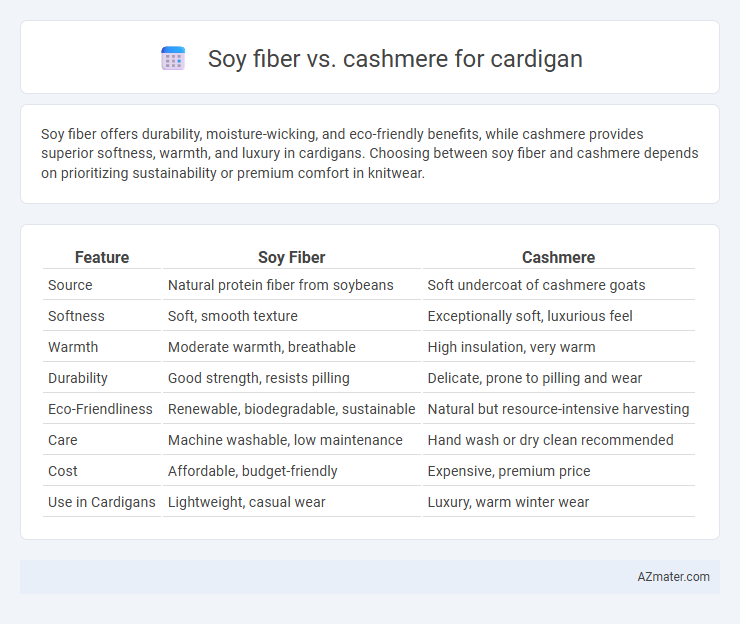Soy fiber offers durability, moisture-wicking, and eco-friendly benefits, while cashmere provides superior softness, warmth, and luxury in cardigans. Choosing between soy fiber and cashmere depends on prioritizing sustainability or premium comfort in knitwear.
Table of Comparison
| Feature | Soy Fiber | Cashmere |
|---|---|---|
| Source | Natural protein fiber from soybeans | Soft undercoat of cashmere goats |
| Softness | Soft, smooth texture | Exceptionally soft, luxurious feel |
| Warmth | Moderate warmth, breathable | High insulation, very warm |
| Durability | Good strength, resists pilling | Delicate, prone to pilling and wear |
| Eco-Friendliness | Renewable, biodegradable, sustainable | Natural but resource-intensive harvesting |
| Care | Machine washable, low maintenance | Hand wash or dry clean recommended |
| Cost | Affordable, budget-friendly | Expensive, premium price |
| Use in Cardigans | Lightweight, casual wear | Luxury, warm winter wear |
Introduction: Comparing Soy Fiber and Cashmere Cardigans
Soy fiber cardigans offer a sustainable and hypoallergenic alternative to traditional cashmere, characterized by its smooth texture and moisture-wicking properties. Cashmere cardigans, derived from the fine undercoat of cashmere goats, are prized for their exceptional softness, warmth, and luxurious feel. Comparing these materials highlights soy fiber's eco-friendly benefits against cashmere's premium quality and insulation, guiding informed choices in cardigan selection.
Origin and Production of Soy Fiber and Cashmere
Soy fiber is derived from the byproducts of soybean processing, primarily extracted from the hulls and textured to create a soft, sustainable textile often called "vegetable cashmere." Cashmere originates from the undercoat of Cashmere goats, primarily found in regions like Mongolia, China, and Iran, where hand-combing or shearing produces fine, warm fibers. The production of soy fiber involves a more industrialized, eco-friendly process using renewable plant material, whereas cashmere relies on animal fibers harvested through labor-intensive methods.
Softness and Comfort Levels
Soy fiber cardigans offer exceptional softness with a silky texture that feels gentle against the skin, making them highly breathable and moisture-wicking for all-day comfort. Cashmere is renowned for its luxurious softness, providing a warm, plush feel that insulates well without bulk, ideal for cooler climates. Both fibers excel in comfort but soy fiber is preferred for lightweight, breathable wear while cashmere delivers superior warmth and a classic, cozy touch.
Durability and Longevity
Soy fiber cardigans offer impressive durability due to their natural resilience and resistance to pilling, maintaining shape and texture over extended wear. Cashmere, while luxuriously soft and warm, tends to be more delicate and prone to wear and thinning with frequent use. For longevity, soy fiber provides a more robust option, ideal for everyday cardigans, whereas cashmere requires careful handling to preserve its premium quality over time.
Breathability and Moisture Wicking
Soy fiber offers superior breathability and moisture-wicking properties compared to cashmere, making it ideal for cardigans worn in warmer climates or during active use. The natural cellulose structure of soy fiber allows for enhanced airflow and quick absorption of sweat, keeping the skin dry and comfortable. In contrast, cashmere, derived from goat undercoat, provides exceptional warmth but tends to retain moisture, which may reduce breathability and limit comfort during high activity or humid conditions.
Eco-Friendliness and Sustainability
Soy fiber, derived from soybean protein, offers a renewable and biodegradable option with low environmental impact due to its use of agricultural byproducts and minimal chemical processing. Cashmere, sourced from the undercoat of cashmere goats, faces sustainability challenges including overgrazing and habitat degradation in regions like Inner Mongolia, leading to ethical and ecological concerns. Choosing soy fiber cardigans supports eco-friendliness through resource-efficient production and reduced carbon footprint, whereas cashmere often requires careful sourcing to mitigate its environmental footprint.
Care and Maintenance Requirements
Soy fiber cardigans require gentle washing in cold water and air drying to maintain their softness and prevent shrinkage, while cashmere demands hand washing with specialized wool detergent or dry cleaning to preserve its delicate texture. Both fibers benefit from storing in breathable garment bags and avoiding direct sunlight to prevent fiber damage and color fading. Proper care extends the longevity of soy fiber and cashmere cardigans, ensuring they retain softness and structural integrity over time.
Allergen and Skin Sensitivity Factors
Soy fiber cardigans offer hypoallergenic properties and are less likely to irritate sensitive skin due to their natural protein-based composition that mimics human skin's keratin. Cashmere, while luxuriously soft, can sometimes cause allergic reactions in individuals sensitive to lanolin, a wax found in goat hair. For those prone to skin allergies, soy fiber provides a gentler and more breathable option compared to cashmere's potential to trigger irritation.
Price Comparison and Value
Soy fiber cardigans tend to be more affordable than cashmere, with prices often ranging from $50 to $150 compared to cashmere's typical $150 to $500 or more. While cashmere offers superior softness, warmth, and luxury, soy fiber provides excellent breathability and eco-friendly benefits at a lower cost. For budget-conscious shoppers seeking comfort and sustainability, soy fiber cardigans deliver strong value, whereas cashmere represents a premium investment in durability and classic elegance.
Final Verdict: Choosing the Right Cardigan Material
Soy fiber cardigans offer excellent moisture-wicking, breathability, and sustainability, making them ideal for eco-conscious consumers seeking lightweight comfort. Cashmere cardigans provide unmatched softness, superior insulation, and luxurious warmth, perfect for cold weather and high-end fashion preferences. The final choice depends on whether durability and eco-friendliness or plush texture and warmth are the primary priorities for the wearer.

Infographic: Soy fiber vs Cashmere for Cardigan
 azmater.com
azmater.com